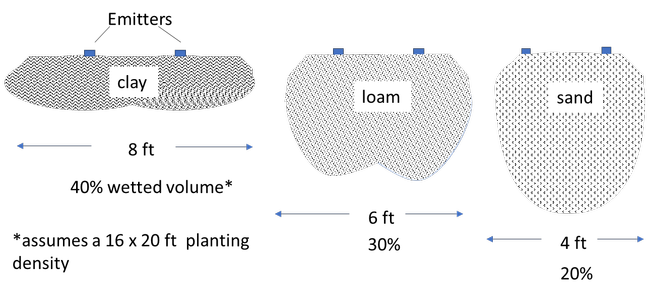The California Department of Water Resources and the University of California Cooperative Extension have teamed up to provide Weekly ET Reports to agricultural water users to assist with irrigation scheduling. The reports include water use information for a variety of crops including almonds, pistachios, walnuts, grapevines, citrus, and stone-fruit of mature bearing age. Adjusted on a weekly basis, water use estimates account for the changing growth stage and weather conditions at the Madera, Parlier, Lindcove, Stratford, Panoche, and Five-Points CIMIS weather stations. Each report gives crop-specific evapotranspiration (ETc, total crop water use including soil evaporation) estimates for the previous and coming week.
Beginning the Irrigation Season
One of the objectives of the weekly ET report is to help managers decide when to initiate the first irrigation.Irrigating too much and too early can lead to reduced growth and yield due to loss of fine feeder roots as well as root disease. Stored soil moisture from winter and early spring precipitation will reduce the need to irrigate early in the season. As ET rates increase and the seasonal crop water use exceeds accumulated rainfall, water managers should consider if there is adequate soil moisture to supply the difference or to begin to irrigation. The weekly ET report provides “Accumulated Precipitation” since January 1st and the “Accumulated Seasonal Water Use” since leaf-out. When water use exceeds precipitation, it may be time to irrigate. Irrigation decisions should be confirmed with field monitoring of soil moisture and plant water status.
Irrigation Frequency and Duration
Managers need to know the application rate of their irrigation system in either inches/hr or gallons/hr and the effective wetted volume (surface wetting and sub-surface lateral subbing) of the root zone as a % of the orchard floor (Figure 1).Different soils will have larger or smaller wetted zones as soils with different texture hold different levels of moisture. This will influence when seasonal irrigation should begin, the appropriate set duration, and frequency of irrigation events throughout the season.
Example: If the effective wetted volume for a sandy loam soil is 25% of the whole orchard floor and crop ET for the week is given as 1.5” (0.21”/day), then the moisture extraction from the wetted area for the week = 1.5”/25% = 6”. A sandy loam soil at field capacity that has approximately 0.8 inches plant available water per foot of soil would have 5” of available moisture in a 5-foot rooting zone. The weekly water use (6” every 7 days) will exceed soil plant available water in about 5 days. In this example, irrigation sets need to be more frequent than once a week, roughly every 3-4 days. The application time for a system with one gallon per hour (gph) emitters that deliver about 1”/day would be calculated as:
Application time = (0.21”/day ET * 3 days)/ 1”/day irrigation * 24 hr/day = 15 hours every 3 days
Irrigation recommendations for common crop spacings are shown in the report in units of inches or gallons of water needed per week. To convert inches per tree to gallons:
Gallons = (Inches * 27,154 gal/acre inch water) / # plantings per acre
Adjusting for System Efficiency
Different irrigation systems can vary greatly in efficiency. Those with high uniformity such as drip micro-irrigation, are roughly 80-95% efficient and require less output to meet crop needs than other systems like flood-furrow, with efficiencies as low as 50%. The recommended amount of water to apply is corrected for a range of irrigation system efficiencies. If the mature almond orchard in the example was 90% efficient, you'd find the 90% column in the second table of the Weekly ET Report, and put in the almond value at 90% (1.67 inches or 0.24 in/day) into the equation above, instead of 1.5 acre-inches.
If you would like to receive weekly reports, have questions or need more assistance contact:
Mae Culumber UCCE Fresno County Nut Crop Advisor, cmculumber@ucanr.edu, 559-241-7526
Elizabeth Fichtner UCCE Tulare County Orchard Systems Advisor, ejfichtner@ucanr.edu, 559-684-3310
Phoebe Gordon UCCE Madera County Orchard Systems Advisor, pegordon@ucanr.edu, 559-675-7879 George Zhuang UCCE Fresno County Viticulture Advisor, gzhuang@ucanr.edu, 559-241-7506
Steve Ewert, California Department of Water Resources, sewert@water.ca.gov, 559-230-3334
Attached Images:
